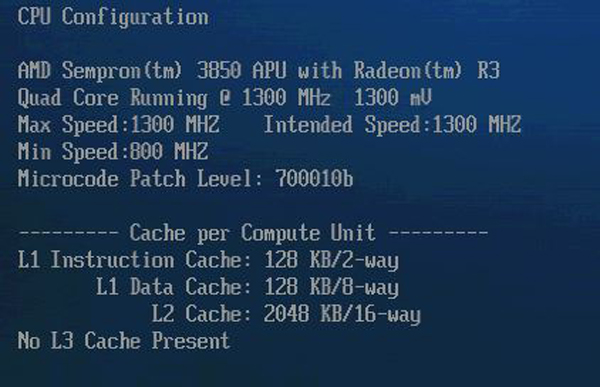Today we are taking a look at the last AMD AM1 processor, the Sempron 3850. We already benchmarked and reviewed the Athlon 5350 “high-end” model as well as the Athlon 5150 mid range option and the Sempron 2650 dual core model. This review completes our data set on the new AM1 family released April 9, 2014. The AMD Sempron 3850 is a 28nm 25w TDP AM1 processor with all four Jaguar generation cores at 1.3GHz. Like the other quad core parts the 3850 has 2MB L2 cache. One still gets the R3 graphics solution based on AMD’s Graphics Core Next (GCN) cores. With low processor performance and single channel memory bandwidth, these are certainly not gaming parts. We are not going to test the GPU today since we typically focus on CPU benchmarks with our Linux test suite. We will have a more in-depth summary of the parts and to Intel alternatives in the next few days.
Test Configuration
We were a bit limited by the fact that we purchased the components at retail prior to the official launch. AMD and ASUS did not provide these components prior to launch.
- CPU: AMD Sempron 3850 (with retail heatsink/ fan)
- Motherboard: ASUS AM1I-A
- Memory: 8GB (2x4GB) DDR3 1600MHz
- SSD: Samsung 840 Pro 256GB
- OS: Ubuntu 13.10 server
- Power supply: PicoPSU 150XT
Although we are testing with 8GB of RAM 4GB is a more likely configuration. The jump to an essentially 50% faster chip is less than $25 at this point. That would likely go along with adding a $20 stick of RAM to the system.
AMD Sempron 3850 Benchmarks
We are using our standard Linux benchmarking suite to get an idea about the AMD Sempron 3850 quad core processor performance. As a direct result of user feedback, we recently had the benchmarks all put into a single script that you can use to benchmark your own systems. As development has progressed on the next version we have moved the current script to STHbench 2013 – Download and Instructions as a resource on the forums. That guide has three simple commands that you can use with a stock installation to run our test suite and install/ compile all necessary files. No configuration is needed. For the next generation development version which currently can also run on CentOS and Mint, and expands the suite to include sysbench and redis-benchmark results, look here: (see Introducing the STHbench.sh Server Benchmarking Script). The net goal is that we want others to be able to reproduce benchmarks and compare directly to their systems. Since we do not have access to every possible configuration, we would appreciate feedback in that thread which can be as simple as posting log files to run. Help is always appreciated!
Hardinfo Performance
hardinfo is a well known Linux benchmark that has been around for years. It tests a number of CPU performance aspects. One major advantage is that one can run this out of the box from many Ubuntu installations.
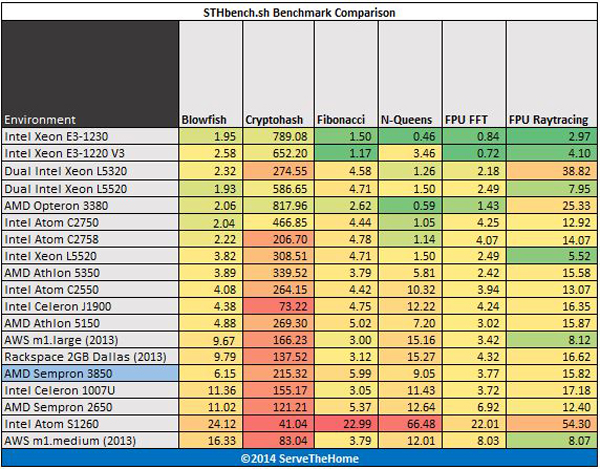
The AMD Sempron 3850 is helped in multi-threaded tests by its quad core processor. On the other hand, the meager 1.3GHz does constrain performance. It is certainly an upgrade to an older Intel Atom SoC (e.g. the D510 and D525).
UnixBench 5.1.3 Performance
UnixBench may be a defacto standard for Linux benchmarking these days. There are two main versions, one that tests single CPU performance on that tests multiple CPU performance. UnixBench segments these results. We run both sets of CPU tests. Here are the single threaded results:
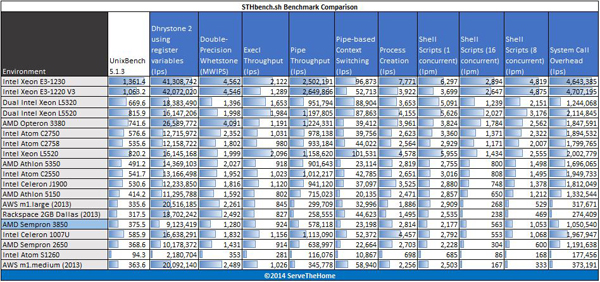
In single threaded tasks, at only 1.3GHz and a relatively simplified core architecture means that throughput naturally gets limited. The Intel Celeron 1007U is a 1.5GHz part but is significantly faster. The Celeron has a 15% higher clock speed but the single threaded performance is about 50% higher.
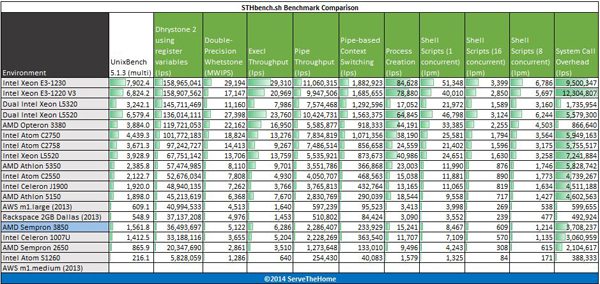
Looking at the UnixBench multi-threaded benchmarks once workloads get parallel, the Sempron 3850 does markedly better. It now just edges out the dual core Celeron 1007U. Looking at the Athlon 5350 results one can see $25 buys about 50% more performance.
c-ray 1.1 Performance
c-ray is a very interesting ray tracing benchmark. It provides both consistent results and some clear separation. Ray tracing is generally a great multi-threaded CPU benchmark. For this test we use both a simple 7500×3500 render and a more complex 1920×1200 render. Here are the results:
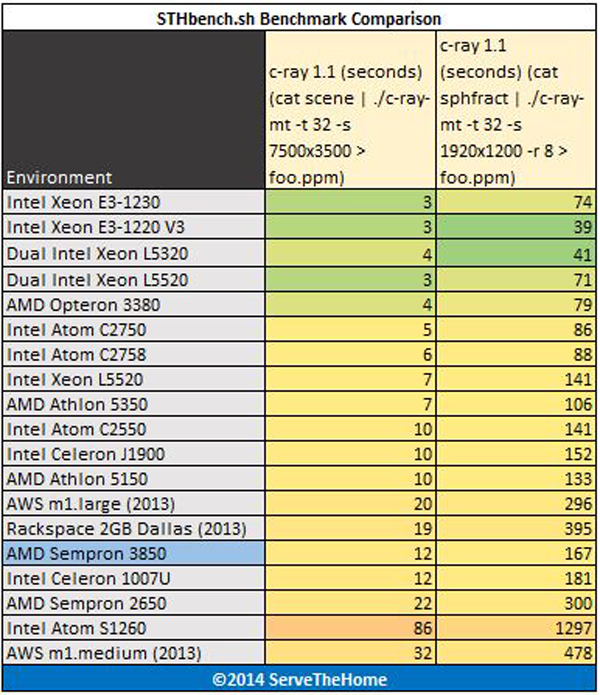
Our c-ray benchmark shows some fairly solid performance using c-ray’s rendering benchmark. The Sempron 3850 c-ray benchmarks are much more competitive than the dual core Sempron 2650 offering, getting relatively close to quad core Silvermont based parts.
Phoronix Test Suite Performance
We are using four tests from the Phoronix Test Suite: pts/stream, pts/compress-7zip, pts/openssl and pts/pybench.
- STREAM by John D. McCalpin, Ph.D. is a very well known memory benchmark benchmark.
- 7-zip compression benchmarks were a mainstay in our Windows suite so we are including it again on the Linux side as a compression benchmark.
- The pts/openssl benchmark is very dependent on the CPU architecture being used
- Python is a widely used scripting language and pyBench is a nice single-threaded Python benchmark
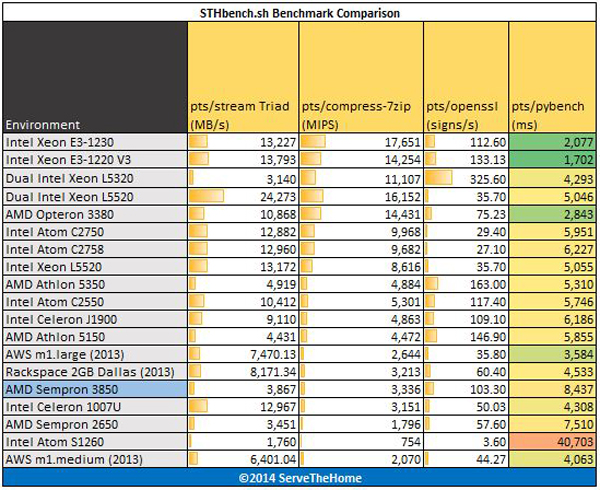
We see memory performance slightly is better with the Sempron 3850. Our Pybench benchmark does struggle as it is constrained by simpler cores running at lower clock speeds.
Crafty Chess Performance
Crafty is a well known chess benchmark. It is also one where we saw issues last time with the Phoronix Test Suite and running on ARM CPUs. We are planning to retire this benchmark in the 2014 version of STHbench. Here are the Crafty Chess results from simply running “crafty bench”:
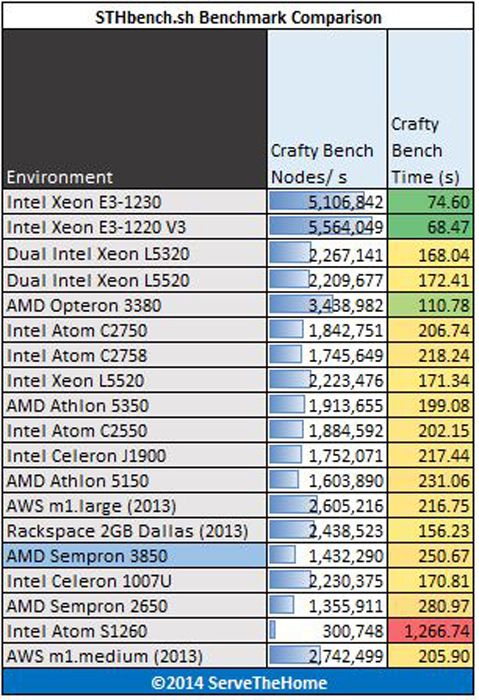
Crafty is very sensitive to clock speeds as a single threaded application. The Sempron 3850 does struggle with this type of workload which should be a key factor for anyone looking at the platform. 1.3GHz is a barrier even mobile phone and tablet processors regularly surpass.
A word on power consumption
Our sample measured a few thenths of a watt lower in idle and load power consumption versus the Athlon 5350 and 5150. We are planning to have a full comparison of all AM1 chips and add in Bay Trail-D.
- Idle power consumption: 15.4w
- Maximum power consumption during benchmarks: 19.2w
We did do thermal imaging on our AMD Athlon 5350 review which gives one a good idea regarding how cool these systems run.
Conclusion
The hardest thing about recommending the AMD Sempron 3850 is the fact that it is $14 less than the Athlon 5150 and $25 less than the Athlon 5350. In the context of a $250 to $300 complete system, one does need to ponder whether it is worth losing significant performance. On the other hand, AMD does have a very interesting model here. If AMD offered Sempron models with five low cost Realtek NICs for example, they could be decent all-in-one network appliances for probably a retail price increase of less than $3. Segmenting the market by $10 increments is hard when the only difference is processor power.

